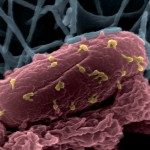Lien vers Pubmed [PMID] – 25803649
Crit. Care Med. 2015 Jun;43(6):e190-8
OBJECTIVE: To study the effect of bacteriophage treatment on highly virulent extraintestinal Escherichia coli pneumonia in mice and compare it with conventional antimicrobial treatment.
DESIGN: Animal investigation.
SETTING: University research laboratory.
SUBJECTS: Pathogen-free 8-week-old Balb/cJRj male mice.
INTERVENTIONS: Two bacteriophages (536_P1 and 536_P7) were isolated from sewage using strain 536, a highly virulent extraintestinal E. coli. Their in vitro and in vivo efficacy against strain 536 and a ventilator-associated pneumonia E. coli were tested. The first group of mice were infected by intranasal instillation of bioluminescent strain 536 and received 536_P1 intranasally, ceftriaxone, or control. The second group of mice was infected with the ventilator-associated pneumonia strain and received 536_P7. Adaptation of 536_P7 to this clinical isolate was also evaluated in vitro and in vivo.
MEASUREMENTS AND MAIN RESULTS: In vivo efficacy of bacteriophage and antibiotic treatment were assessed by recording bioluminescence for short-time periods and by recording body weight and survival of mice for longer periods. Both treatments improved survival compared with control (100% vs 0%), and in vivo bioluminescence recordings showed a similar rapid decrease of emitted light, suggesting prompt bacterial clearance. The majority of mice infected by the ventilator-associated pneumonia strain were not rescued by treatment with 536_P7; however, in vitro adaptation of this bacteriophage toward the ventilator-associated pneumonia strain led to isolate a variant which significantly improved in vivo treatment efficacy (animal survival increased from 20% to 75%).
CONCLUSIONS: Bacteriophage treatment was as effective as antibiotherapy to provide 100% survival rate in a lethal model of highly virulent E. coli pneumonia. Adaptation of a bacteriophage is a rapid solution to improve its efficacy toward specific strains. These results suggest that phage therapy could be a promising therapeutic strategy for ventilator-associated pneumonia.



